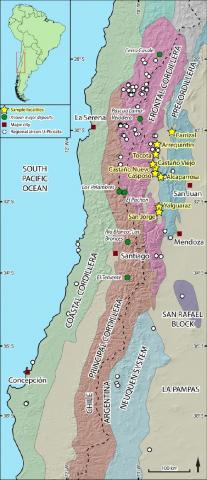Gregory H. Poole, Anthony I. S. Kemp, Steffen G. Hagemann, Marco L. Fiorentini, Heejin Jeon, Ian S. Williams, Eduardo O. Zappettini & Nora A. Rubinstein
2 020
Contributions to Mineralogy and Petrology volume 175, Article number: 89 (2020)
The Andean margin of the South American continent has been magmatically and tectonically active for over 330 million years. It is the type location where “Cordilleran-type” magmatism and orogenesis are manifest. In Argentina and Chile, between the latitudes of 28° and 40° S, magmatism related to the Gondwanan “Cordilleran-type” orogeny is reflected in a series of Carboniferous to Triassic intrusions. A comprehensive model exists for the petrogenesis of such magmas in Chile, however there is relatively little understanding of the nature and timing of Permo-Triassic magmatism in the Frontal Cordillera and Precordillera in Argentina. To address this, we present a new dataset of in situ zircon U–Pb, O and Hf isotopes from 15 felsic intrusions from Argentina. Zircon geochronology shows that magmatism in this region commenced at ca. 285 Ma and continued until ca. 250 Ma. Zircon O and Hf isotopes suggest that the oldest Permian magmas were derived from young supracrustal sources, with elevated δ18O (~ 8.5 to 7.5‰) and negative εHf values (~ − 1 to − 3 εHf). The emplacement of these magmas was coeval with the formation of mantle-derived magmas characterised by mantle-like δ18O (~ 6.0 to 5.5‰) and moderately positive εHf values (~ 4 to 1 εHf). As magmatism continued, transitional isotope signatures became predominant as melts of these disparate sources interacted and hybridised. It is proposed that under a compressional regime, mantle-derived magmas were halted in the lower continental crust, where they exchanged heat and volatiles with an older fertile lithosphere to generate melts from supracrustal sources. A shift in the stress regime at ca. 285 Ma permitted both crustally derived and juvenile mantle-derived magmas to exploit newly formed conduits to rise into the upper crust. A regional compilation of zircon O and Hf isotopes from felsic igneous rocks reveals a coherent secular trend over ~ 100 million years, where the oldest magmatism exhibits a dominant supracrustal component and younger magmas progressively (over 50 Ma) transition towards juvenile mantle-like isotopic compositions. This new dataset from Argentina fills a significant gap in the previous regional models between 285 and 250 Ma and documents the isotopic response of magmas produced in back-arc regions to a transition between compression and extensional/neutral stress regimes. These results give insight into the generation of new, or recycling of, continental crust in a back-arc setting and how the transition from compression to extension is imperative for ore-forming magmas to reach the upper crust.
https://link.springer.com/article/10.1007/s00410-020-01721-0

